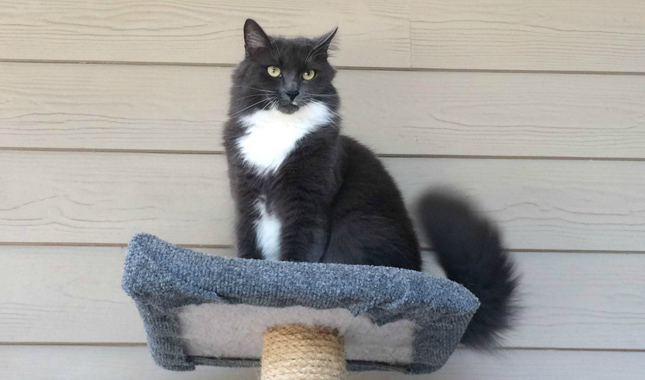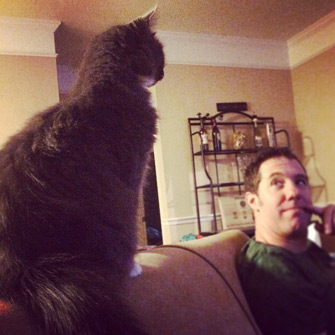Teaching My Cat to Love My Husband — Step 3
Published on May 07, 2015
Vetstreet contributing editor Kristen Seymour’s husband, Jared, loves cats. Unfortunately, their cat, Trixie, doesn’t care much for Jared — so they’ve enlisted trainer Mikkel Becker to help them teach Trixie that Jared is actually kind of a catch. This post is the third in a series — you can check out part one here and part two here. And be sure to follow along for the next month as Mikkel and Kristen report back on their progress.

When Kristen approached me about helping her cat and her husband make friends, I asked her for some basic background information. She told me that Trixie is a rescue cat who came to live with them after spending time in a shelter. Before that, Trixie was essentially feral, which may have a lot to do with her hesitation around people in general and Jared in particular. With this information, plus some other things Kristen told me about Trixie and Jared, I’m working with them to establish some clear goals before they start training.
Decoding Trixie’s Personality
Based on Kristen’s descriptions of Trixie’s behavior, it sounds to me like Trixie is generally conflicted about people: She wants to be near Jared and Kristen and their friends, but is easily overwhelmed by too much interaction. For instance, Kristen mentions that Trixie is OK with being petted, but only at a time and place of her choosing. Trixie’s hesitance to let even Kristen pet her leads me to think that her reticence has less to do with Jared and more to do with Trixie’s own preferences about touch and proximity.
But according to Kristen, Trixie is not antisocial; she will go up to new people, men and women, and rub herself on them in greeting. For Trixie, rubbing up on new people may help her to feel safe and comfortable around them, if only because she has marked them with her scent. This behavior is actually quite common — a fearful cat will often investigate new people, but will only stay around as long as the interaction continues on the cat’s terms. As soon as there is any effort made to pet or touch the cat, her comfort level decreases and she is likely to flee.
It seems likely that Trixie’s resistance to touch is what is getting in the way of her relationship with Jared. Kristen provided me with a video of Jared hanging out with Trixie. It looks to me as though she wants to interact with him and isn’t averse to his presence, but as soon as he reached out to touch her, she scooted away. My guess is that it is the petting she doesn’t like, not Jared himself. Unfortunately, since Jared has been trying to bond with Trixie by petting her, he may have unintentionally created a situation in which Trixie avoids him because petting — particularly having hands reach for and touch her — is scary to her and she is trying to avoid it at all costs.
In addition to avoiding touch or petting, there could be other reasons why Trixie is less comfortable around Jared than she is around Kristen. Kristen mentioned that Jared has a low-level allergy cough; this may be distressing to Trixie, particularly since it is unpredictable. It could also be that Trixie is more cautious around Jared because he’s a man and has a deeper voice and a bigger body. Her reticence could also be related to something that happened before she came to live with Jared and Kristen. It is difficult to pinpoint exactly why she hasn’t warmed up to Jared after all this time, but that doesn’t mean there’s no hope for the two of them to form a bond.

Establishing Realistic Training Goals
Before Kristen and Jared can begin training, it is important that we develop some reasonable goals and expectations to help guide their training. Even though we’re not sure why Trixie is still hesitant around Jared, we can use what we know about her personality to develop some strategies.
For starters, it sounds as if Trixie is relatively sensitive to close contact, which is important to take into account. Knowing this will help us determine what a realistic goal will be for Trixie. For instance, she may never be the type of cat that could sit for hours at night on Jared’s lap (or anyone else’s, for that matter) while he pets her — we already know that she is picky about this type of interaction, even with Kristen, who is her favorite human. A more reasonable goal would be to help Trixie feel safe enough that she can spend time in close proximity to Jared and not bolt away when he’s near. Another reasonable goal would be to get Trixie comfortable enough around Jared that she would be willing to accept some limited petting from him on occasion.
Only Kristen and Jared can decide on their specific goals, but I always encourage people to find goals that fit realistically with their cat’s preferences and personality. Sometimes, during training, goals will need to be adjusted depending on how the feline responds and how much time can be dedicated to the process. These adjustments can be helpful in finding the right fit for both the cat and her humans.
Helping Trixie Get Comfortable With Jared
I would say that overall, the most important goal is for Trixie to feel completely safe around Jared. Kristen and Jared have already made some changes in this direction. Jared is feeding Trixie her meals as often as possible, but he does not linger after he gives her the food; instead, he offers her dinner and then immediately walks away. This helps Trixie associate Jared with something good (her dinner) while it eliminates the things that worry her (the chance that he might pet her, for example).
In general, it is important that Jared avoid interactions that Trixie dislikes or make her uncomfortable, such as petting or direct eye contact. During their normal interactions with Trixie, Jared and Kristen should both avoid these triggers in order to make Jared’s presence less scary and more positive.
To help dispel Trixie’s anxiety, Jared should only approach Trixie in areas where she is comfortable — in this case, her perches and perhaps the couch. This will mean that he should avoid moving toward her unless she’s up somewhere high.
Jared should also sit on the sofa or the floor for all interactions with Trixie, instead of standing or bending over her. This signals that he is more planted and less likely to move, and also puts him closer to her level. He should sit with his body turned sideways and should avoid making direct eye contact with Trixie; instead, he should watch her out of the corner of his eye and blink slowly.
As Jared alters the way he interacts with her in the normal routine of their day, Trixie will start to see him not as a threat, but as someone safe. Once that happens, it will be time to start working with her on some specific training strategies.
One final note: Every family, animal and situation is unique, and not every strategy will work in every situation. In addition, it is always important to start any behavior-modification process with a visit to the veterinarian to check for underlying health issues, as these may be contributing factors to any behavior issue.
More on Vetstreet:





